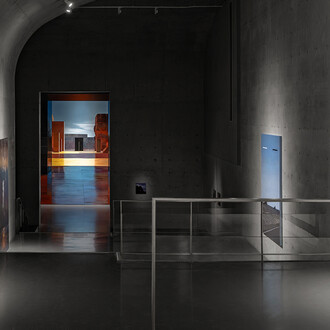Perrotin Shanghai is proud to present Sol LeWitt: Wall Drawings, a landmark exhibition of this foremost figure of the American Conceptual and Minimal Art movements of the 1960s and 1970s. The exhibition focuses on LeWitt’s seminal wall drawings and includes 16 ink- wash works initially conceived in the 1980s and 1990s, including a monumental, immersive wall drawing spanning four walls. This marks the first exhibition of LeWitt’s wall drawings in mainland China.
Sol LeWitt exhibited widely in the 1960s, a time of great social and political change in the United States. Living and working in culturally rich and progressive New York City, the artist's practice mined his interest in seriality, form, and color and increasingly probed the dematerialization of art. In 1967, LeWitt published “Paragraphs on Conceptual Art,” where he asserted that, “the idea becomes a machine that makes the art.” This pioneering concept is exemplified in his ongoing series of wall drawings, for which rule-based installation instructions were conceived by the artist to be later carried out by assistants.
In the late 1980s, LeWitt devised a system of superimposing pigments, applied in layers, with ink soaked rags. The wall drawings that comprise this exhibition make use of this technique to create luminous, multifaceted geometric and abstract forms. For example, wall drawings from the series Wall Drawing #606 A-K: Forms derived from a cubic rectangle, with color ink washes, are installed in a striking grid that spans an entire wall and implement the layered application of saturated gray, yellow, red, and blue planes of color. Meanwhile, the monumental Wall Drawing #624: On four walls, arcs 10 inches (25cm) wide from the midpoint of the right side of one wall, with alternating gray, white; yellow, white; red, white; blue, white bands, transforms an entire room with its ebullient curved bands. LeWitt's methodical exploration of form and color and position that an idea is as important as the physical artwork continues to challenge notions of art production and the role of the artist.
Sol LeWitt (1928 – 2007) was born in Hartford, Connecticut, in a Russian-Jewish family. He graduated from Syracuse University in 1949 before serving in the Korean War. In 1953 he moved to New York where he worked as a graphic designer for magazines and, later, for architect at I.M. Pei. LeWitt attended New York’s School of Visual Arts while working as night clerk at the Museum of Modern Art. During this period, LeWitt was exposed to important works of modern art but perhaps one of the most formative discoveries during this period was of nineteenth- century photographer Eadweard J. Muybridge. Muybridge’s depiction of the phases of movement through serial images proved extremely influential to LeWitt, whose own work became increasingly concerned with seriality.
LeWitt’s work was first publicly exhibited in 1963 at St. Mark’s Church. His first one-person show was at the John Daniels Gallery in New York and since then, LeWitt has had hundreds of one-person exhibitions. The Gemeentemuseum in The Hague presented his first retrospective exhibition in 1970, and his work was later shown in a major mid-career retrospective curated by Alicia Legg at the Museum of Modern Art, New York in 1978. LeWitt’s works are in numerous public collections including the Museum of Modern Art, the Whitney Museum of American Art, the Solomon R. Guggenheim Museum, the Art Institute of Chicago, the San Francisco Museum of Modern Art, the Centre National d’Art Moderne Georges Pompidou, Paris, the Stedelijk Museum Amsterdam, Turin’s Castello di Rivoli, the Moderna Museet Stockholm and the Tate Gallery, London. In November 2008 “Sol LeWitt: A Wall Drawing Retrospective” opened at MassMOCA (Massachusetts Museum of Contemporary Art), and will remain on view for 25 years. In September 2018 the Estate of Sol LeWitt announced the digital publication of "Sol LeWitt Wall Drawings Catalogue Raisonné" by Artifex Press. This definitive collection features comprehensive information for LeWitt’s wall drawings.
















